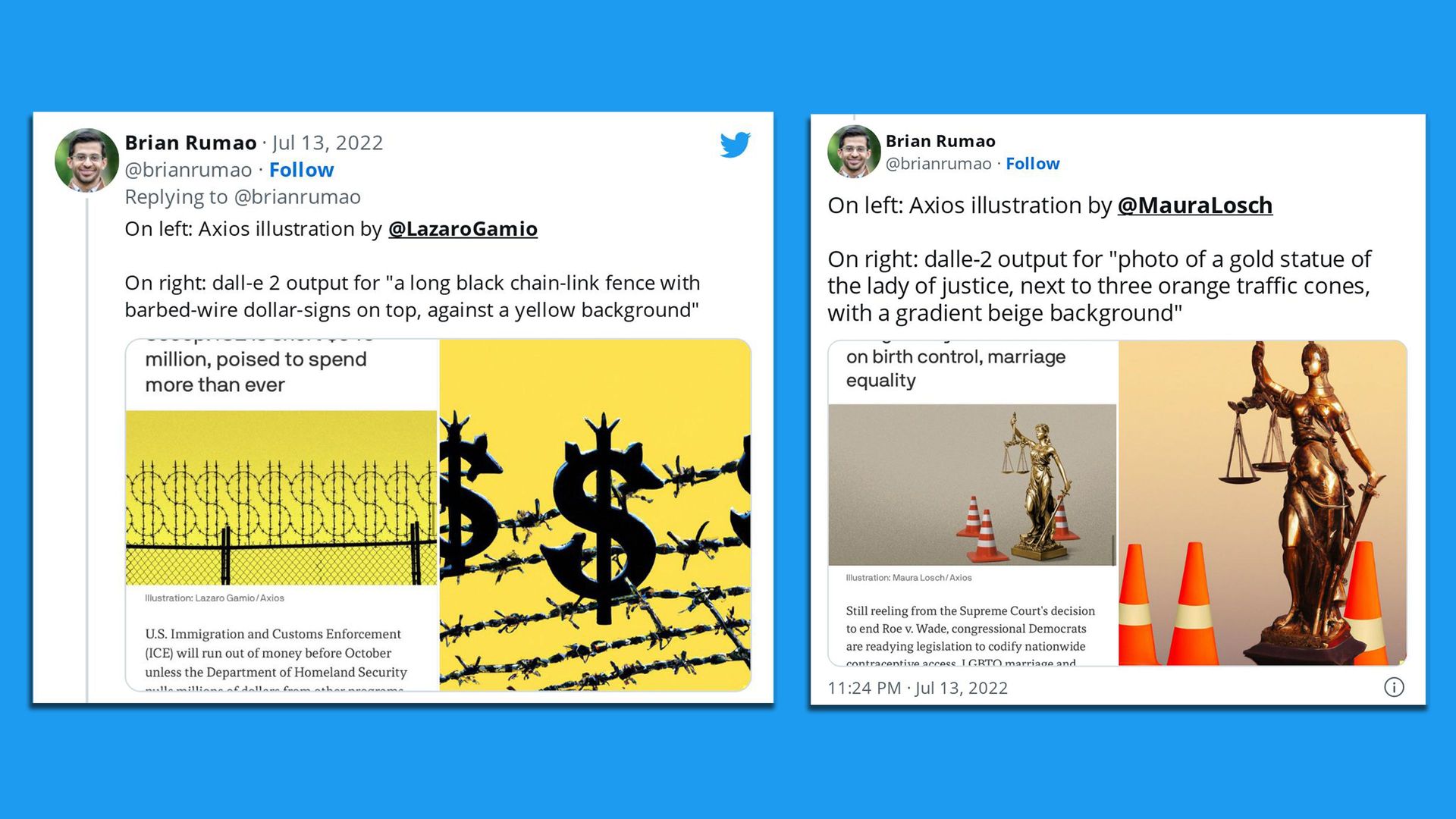| | | | | | | Presented By Aventiv Technologies | | | | Axios What's Next | | By Joann Muller, Jennifer A. Kingson and Alex Fitzpatrick · Aug 10, 2022 | | Alex here. The big climate bill is, by and large, great news for Planet Earth. But there's a pretty big asterisk for prospective electric car buyers, Joann reports today. Today's Smart Brevity count: 1,014 words ... 4 minutes. | | | | | | 1 big thing: Buy your EV now |  | | | Illustration: Shoshana Gordon/Axios | | | | If you're thinking of buying an electric car any time soon, you'd better place your order before President Biden signs the Democrats' big climate, tax and health care package into law, Joann Muller reports. Why it matters: Democrats initially hoped to dramatically increase EV adoption via the bill, called the Inflation Reduction Act, by expanding existing consumer tax credits. - But strict supply chain requirements added by Sen. Joe Manchin will instead likely slow the nation's switch from gas-powered cars — at least in the short run.
Driving the news: To get Manchin to go along with the broader bill, the rest of the Senate Democrats agreed that only cars with batteries containing a certain percentage of materials sourced from North America or U.S. trading partners will qualify for the credits moving forward — even though that doesn't line up with manufacturing reality. - Although automakers, suppliers and battery processing companies are racing to invest in a domestic supply chain, it will be years before those facilities are up and running. For now, the EV supply chain is mostly dominated by China — but any cars using Chinese-made battery components would be disqualified from tax credits under the new bill.
- The bill tries to take that into account by phasing in the battery and minerals requirements over time, and the industry is getting lots of financial help to set up domestic production.
- But certain provisions — like a new requirement that EVs must be assembled in North America to be eligible for the credits — will take effect immediately after the president signs the bill into law.
- That will automatically trim the list of eligible vehicles from 72 to about 25, according to the Alliance for Automotive Innovation, an auto industry lobbying group.
Zoom out: To pass the new bill, Senate Democrats needed to be fully unified — giving Manchin lots of leverage to extract concessions. What they're saying: "The $7,500 credit might exist on paper, but no vehicles will qualify for this purchase incentive over the next few years," John Bozzella, the Alliance for Automotive Innovation's president and CEO, writes in a blog post. - "That's a missed opportunity at a crucial time and a change that will surprise and disappoint customers in the market for a new vehicle," Bozzella writes, adding it will also be a "major setback" to the country's effort to hit 40-50% electric vehicle sales by 2030.
Yes, but: People will buy EVs even without federal tax credits — especially if gas prices stay relatively high — but only if they're available. Inventories are tight, and prices are rising sharply. - In the long run, building a domestic EV supply chain should make electric cars cheaper — eventually.
What's next: The House of Representatives is expected to approve the bill Friday, sending it to Biden's desk. Share this story. |     | | | | | | 2. Can AI be our next illustrator? |  | | | Screenshot of Brian Rumao's Twitter feed | | | | After one of our readers used AI image generator DALL-E to create Axios-style illustrations, our visual journalists started wondering: Could we use this technology the same way? Why it matters: Computers are getting better at doing what humans can do, including creating art from scratch. But design is much more than mashing shapes together. Axios illustrators begin each project by pinpointing a story's key ideas. - Next, they conceptualize visual representations of the story's themes and brainstorm how to tie those themes together to create a metaphor.
- After producing several mockups, illustrators often select a version that best conveys an idea.
An example: A story about two health care startups merging might prompt an illustrator to depict "digital," "health" and "merger." - The final version might be two syringes tied together with an ethernet cable.
Yes, but: Editorial illustration requires a level of conceptualization, visual metaphor and story connection that AI tools like DALL-E can't yet replicate, our team found. - They are, however, powerful tools to generate colors, ideas, patterns, textures, or mood boards for larger projects.
Read the rest. |     | | | | | | 3. Turning houses into "virtual power plants" |  | | | Photo illustration: Sarah Grillo/Axios. Photo: Bettmann/Contributor via Getty Images | | | | A California non-profit is using virtual power plant tech to address the state's housing crisis while relieving its increasingly strained electric grid, climate news site Grist reports. Why it matters: It's an innovative, if embryonic, attempt at solving two big socioeconomic problems at once. Details: The group, RCF Connects, is retrofitting aging homes with cutting-edge, climate-friendly tech like solar panels, electric heat pumps and more. - The completed houses are then offered to low- and middle-class families searching for a starter home.
- Because they can generate their own electricity and supply excess power back to the grid, RCF's homes function as what are known as "virtual power plants," or VPPs.
- VPPs can reduce demand on electric grids during peak times (like heatwaves) as well as reduce homeowners' energy costs.
What they're saying: "It's not a power plant in the way that we've historically looked at them," Andy Bennett, CEO of VPP software firm mPrest, told Grist. "But you've created that same virtual capacity on the grid." Yes, but: RCF has finished only 20 such renovations so far. |     | | | | | | A message from Aventiv Technologies | | Technology can empower rehabilitative justice and reduce recidivism | | |  | | | | Aventiv Technologies is ending technology deserts in correctional facilities and helping those incarcerated stay connected and build new lives. Here's how: Aventiv is on pace to distribute 600,000 free tablets with educational content. It reduced call rates by more than 25%. Find out more. | | | | | | 4. Abortion comes to The Sims — unofficially |  | | | Illustration: Aïda Amer/Axios | | | | Fan-made add-ons allowing The Sims characters to have abortions are increasingly popular, their creators tell Axios' Stephen Totilo. Why it matters: Big video game studios often avoid socially sensitive topics — but fans sometimes find ways to work them in via "mods," or unofficial modifications. That's the case with abortion and Electronic Arts' The Sims, in which players initiate digital people's births, marriages, careers and intimate moments. - It's a daring series, with a history of including socially progressive topics, such as same-sex romance. Yet it hasn't gone there with abortion — at least not officially.
Details: One popular abortion mod for the Sims 4, LittleMsSam's "Miscarriage Chance & Abortion," was released in 2018 and has been downloaded more than 250,000 times since mid-2021, its creator tells Axios. Read the rest. |     | | | | | | 5. 📸 China's new suspension maglev |  | | | Photo: VCG via Getty Images | | | | Above, a woman takes photos of China's first permanent maglev-suspension monorail during a Tuesday trial run in China's Jiangxi Province. - The train can hold nearly 100 passengers and reach a speed of about 50 mph, per state media.
|     | | | | | | A message from Aventiv Technologies | | Creating connections for those who need it most | | |  | | | | Many correctional facilities are digital deserts. Incarcerated individuals need more ways to connect with family and build new lives. The solution: Aventiv is delivering 600,000 free tablets with educational content and cut call rates by over 25%. See all the progress. | | | | A hearty thanks to today's What's Next copy editor, Rob Reinalda. Was this email forwarded to you? Get your daily dose of What's Next magic by signing up here for our free newsletter. |  | | Are you a fan of this email format? It's called Smart Brevity®. Over 300 orgs use it — in a tool called Axios HQ — to drive productivity with clearer workplace communications. | | | | | | Axios thanks our partners for supporting our newsletters. If you're interested in advertising, learn more here.
Sponsorship has no influence on editorial content. Axios, 3100 Clarendon Blvd, Arlington VA 22201 | | | You received this email because you signed up for newsletters from Axios.
Change your preferences or unsubscribe here. | | | Was this email forwarded to you?
Sign up now to get Axios in your inbox. | | | | Follow Axios on social media:    | | | | | |









0 Comments